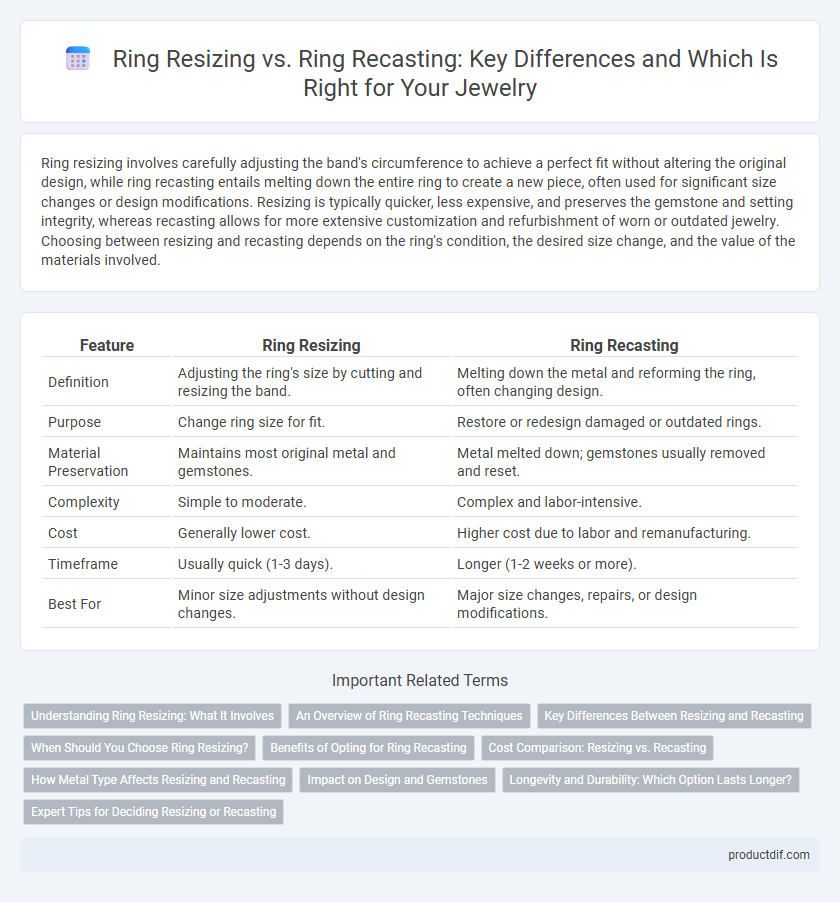Ring resizing involves carefully adjusting the band's circumference to achieve a perfect fit without altering the original design, while ring recasting entails melting down the entire ring to create a new piece, often used for significant size changes or design modifications. Resizing is typically quicker, less expensive, and preserves the gemstone and setting integrity, whereas recasting allows for more extensive customization and refurbishment of worn or outdated jewelry. Choosing between resizing and recasting depends on the ring's condition, the desired size change, and the value of the materials involved.
Table of Comparison
| Feature | Ring Resizing | Ring Recasting |
|---|---|---|
| Definition | Adjusting the ring's size by cutting and resizing the band. | Melting down the metal and reforming the ring, often changing design. |
| Purpose | Change ring size for fit. | Restore or redesign damaged or outdated rings. |
| Material Preservation | Maintains most original metal and gemstones. | Metal melted down; gemstones usually removed and reset. |
| Complexity | Simple to moderate. | Complex and labor-intensive. |
| Cost | Generally lower cost. | Higher cost due to labor and remanufacturing. |
| Timeframe | Usually quick (1-3 days). | Longer (1-2 weeks or more). |
| Best For | Minor size adjustments without design changes. | Major size changes, repairs, or design modifications. |
Understanding Ring Resizing: What It Involves
Ring resizing involves adjusting the circumference of an existing ring to fit the wearer's finger more comfortably, typically by adding or removing metal without altering the ring's original design. This process is suitable for minor size changes and preserves the structural integrity and gemstones of the ring. Unlike ring recasting, resizing is a less invasive and more cost-effective method to achieve a perfect fit while maintaining the original craftsmanship.
An Overview of Ring Recasting Techniques
Ring recasting involves melting down the original metal to create a new ring, allowing for significant design changes or repairs without compromising the metal's integrity. Techniques such as lost-wax casting, centrifugal casting, and vacuum casting ensure precise replication and high-quality finishes in the recasting process. This method is ideal for transforming worn-out rings or resizing beyond standard limits while maintaining the value and durability of precious metals like gold, silver, and platinum.
Key Differences Between Resizing and Recasting
Ring resizing involves adjusting the band size by cutting and adding or removing metal to achieve a perfect fit, typically preserving the original design and gemstones. Ring recasting melts down the entire ring to create a new piece, allowing for design changes but potentially compromising intricate details and original craftsmanship. The primary differences lie in the extent of alteration, impact on the ring's structure, and suitability for preserving antique or delicate jewelry.
When Should You Choose Ring Resizing?
Choose ring resizing when the ring's original design and gemstone setting remain intact, and only minor size adjustments are needed, typically within one or two sizes. Resizing preserves the integrity of delicate details and is more cost-effective compared to ring recasting, which is better suited for significant size changes or complete ring redesigns. Opting for resizing ensures the ring maintains its original craftsmanship and sentimental value without extensive modification.
Benefits of Opting for Ring Recasting
Ring recasting offers the advantage of restoring a ring to its original condition with enhanced durability and refined details, surpassing the limitations of simple resizing. This process allows for customization, including design modifications and metal refinements, resulting in a renewed piece that fits perfectly and retains its aesthetic value. Opting for ring recasting ensures long-term preservation and the ability to update the ring to current styles without compromising its intrinsic quality.
Cost Comparison: Resizing vs. Recasting
Ring resizing typically costs between $20 and $100, depending on the complexity and metal type, making it a cost-effective option for minor adjustments. Ring recasting, which involves melting and reforming the metal, can range from $150 to $500 or more due to the labor-intensive process and materials required. Choosing resizing over recasting saves significant expenses when only small size modifications are needed, while recasting is best suited for major size changes or damaged rings.
How Metal Type Affects Resizing and Recasting
Metal type significantly influences the process of ring resizing and recasting due to varying malleability and melting points. Gold and platinum rings are more adaptable for resizing because of their ductility, while metals like titanium and tungsten require recasting for any size adjustments due to their hardness. Understanding metal-specific properties ensures precise resizing or recasting, maintaining the ring's structural integrity and aesthetic appeal.
Impact on Design and Gemstones
Ring resizing preserves the original design and gemstone setting, allowing minor adjustments without compromising structural integrity. Ring recasting involves melting down the metal and reforming the ring, which may alter intricate design details and jeopardize gemstone stability due to heat exposure. Choosing resizing or recasting depends on the extent of size change and the complexity of the ring's design and gemstone arrangement.
Longevity and Durability: Which Option Lasts Longer?
Ring resizing preserves the original metal structure, maintaining durability and longevity without compromising the integrity of the band. Ring recasting involves melting and reforming the metal, which can slightly weaken the material over time due to repeated heating and cooling cycles. For long-term wear, resizing generally offers better durability, while recasting may be suited for significant design changes but potentially reduces the ring's lifespan.
Expert Tips for Deciding Resizing or Recasting
Expert tips for deciding between ring resizing and recasting depend on the ring's material, design complexity, and condition. Resizing is ideal for simple bands and minor size adjustments, preserving the original craftsmanship and gemstones. Recasting suits heavily damaged or significantly altered sizes, allowing for complete redesign and restoration to original quality.
Ring Resizing vs Ring Recasting Infographic

 productdif.com
productdif.com